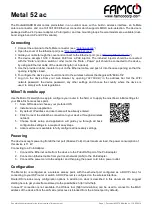
The system bus backplane contains multiple buses for connecting the modules. It has no active component.
Different buses provide power to the modules, transfer of data, timing control, system commands, and other
functionality.
Cisco WAN Switch Network Topologies
We’ve talked about the transmission media, the signal, and the equipment. Let’s put it all together. Cisco
classifies WAN topologies into three designs: flat, tiered, and structured.
In a flat design, the WAN switches are connected in a fully meshed network. All the nodes are aware of one
another. Each node can send traffic to another node with a direct connection. This design is only suitable in a
small WAN network (private enterprise network). Figure 3.5 displays a typical flat WAN network.
Figure 3.5: : A flat WAN network.
In a tiered network, the core WAN switches have to route traffic for other nodes. This design utilizes edge
switches as feeders to the network. The feeders aggregate multiple narrowband transmissions into broadband
trunk connections to the core switches. The edge switches can be right next to the core switch, or they can be
miles apart. The IGX series and the MGX 8800 series can be configured as core switches or feeders. The BPX
can only be configured as a core switch, whereas the MGX 8200 series can only be a feeder node. Figure 3.6
displays how a tiered network combines different equipment.
Figure 3.6: A tiered WAN network.
The structured network design is a combination of flat networks and tiered networks. Each of these networks
is considered a domain. All domains have a unique number. Each domain is attached to others through
switches called junction nodes that are responsible for routing across domains. Switches other than junction
60
Summary of Contents for Catalyst 1900 Series
Page 1: ......
















































